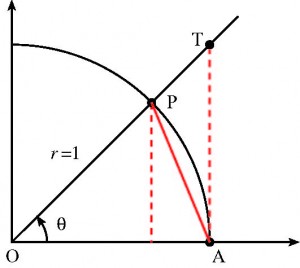One very important application of the squeeze theorem is the proof that \(\displaystyle \lim_{\theta \to 0} \frac{\sin \theta}{\theta} = 1\). We present this proof next.
 This proof is for the limit as \(\theta\to 0^+\). The case for \(\theta\to 0^-\) can be proved in exactly the same manner and we leave it as an exercise to the student.
This proof is for the limit as \(\theta\to 0^+\). The case for \(\theta\to 0^-\) can be proved in exactly the same manner and we leave it as an exercise to the student.
Consider the figure to the right. Notice that the area of the triangle OAP is less than the area of the sector OAP which is in turn less than the area of the triangle OAT. Let’s estimate each of these areas in turn.
\begin{align*}
\mbox{Area of triangle OAP} &=
\frac{1}{2} \mbox{base} \times \mbox{height}\\
&= \frac{1}{2} (1) \sin \theta = \frac {1}{2} \sin \theta.\\
\mbox{Area of sector OAP} &=
\frac{1}{2} r^2 \theta = \frac{1}{2} (1) \theta =
\frac {1}{2} \theta.\\
\mbox{Area of triangle OAT} &=
\frac{1}{2} (1) \tan\theta = \frac{1}{2} \tan\theta.
\end{align*}
Using our initial observation, one has $$\frac{1}{2} \sin \theta \le \frac{1}{2} \theta \le \frac{1}{2} \tan \theta, \hspace{1cm} 0 \le \theta < \frac{\pi}{2}.\hspace{2cm}(1)$$The inequality for \(-\pi/2 < \theta \le 0\) is \(\tan\theta\le\theta\le\sin\theta\). From the left hand side of (1) one has \(\sin\theta\le\theta\) or \((\sin\theta)/\theta\le 1\) if \(\theta \ge 0\). From the right hand side we have \(\theta \le \tan\theta\) or \(\cos\theta\le (\sin\theta)/\theta\) if \(\theta \ge 0\). In other words,$$\cos \theta \le \frac{\sin \theta}{\theta} \le 1$$provided \(0\le\theta<\pi/2\). Again, we leave it to the student to verify that this last inequality is true for \(-\pi/2<\theta\le 0\). At this point, we look at the limit as \(\theta\to 0\) and apply the squeeze theorem:$$\lim_{\theta\to 0} \cos \theta \le
\lim_{\theta\to 0} \frac{\sin \theta}{\theta} \le \lim_{\theta\to 0} 1.$$Since the left and right hand sides has a limit of one, we can conclude that $$\lim_{\theta\to 0} \frac{\sin \theta}{\theta} = 1.$$This limit is used so often in calculus it is a good idea to remember it. We leave this material with two examples that use this new result.
Examples:
1. Find \(\displaystyle \lim_{x\to 0}\frac{\sin^2 x}{x}\).
Again, we use the limit laws, $$\lim_{x\to 0} \frac{\sin^2 x}{x} = \left(\lim_{x\to 0} \frac{\sin x}{x}\right) (\lim_{x\to 0} \sin x) = 1\cdot 0 = 0.$$
2. Find \(\displaystyle \lim_{x\to 0}\frac{1-\cos x}{x^2}\).
For this one we need to multiply by the conjugate of the numerator,
\begin{align*}
\lim_{x\to 0}\frac{1-\cos x}{x^2} &=
\lim_{x\to 0}\frac{1-\cos x}{x^2}
\left(\frac{1+\cos x}{1+\cos x}\right) =
\lim_{x\to 0}\frac{1-\cos^2 x}{x^2(1+\cos x)}\\ &=
\lim_{x\to 0}\frac{\sin^2 x}{x^2(1+\cos x)} =
\left(\lim_{x\to 0}\frac{\sin x}{x}\right)^2
\lim_{x\to 0}\frac{1}{1+\cos x}
= 1^2 \cdot \frac{1}{2} = \frac{1}{2}.
\end{align*}